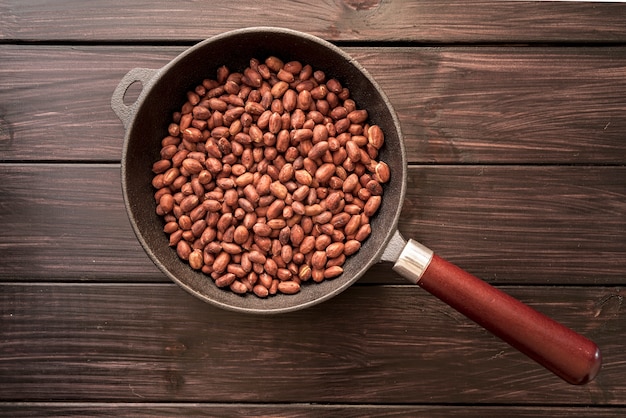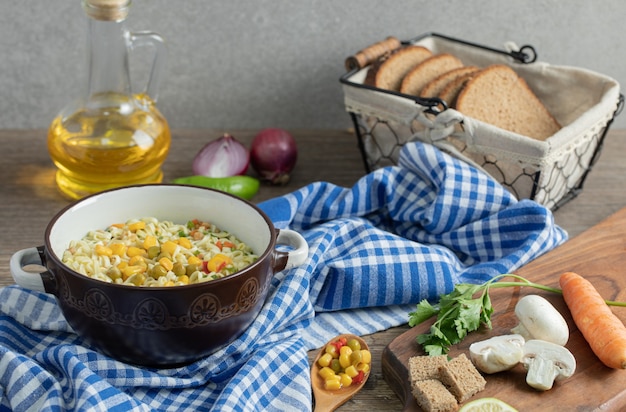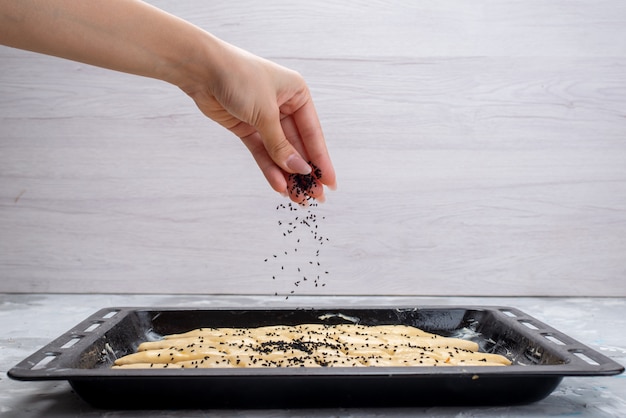Lentils are a true kitchen hero. They're affordable, versatile, and packed with goodness, making them a staple in my household. From hearty stews to vibrant salads, there's a lentil recipe for every mood and occasion. But let's be honest, cooking lentils can sometimes feel like a bit of a gamble. One minute you're stirring a bubbling pot, the next you're staring at a mushy mess. But fear not, my fellow lentil lovers, because I'm here to guide you through the ins and outs of achieving lentil perfection on the stovetop.
This guide is your one-stop shop for conquering the world of lentil cooking. We'll dive into the different types of lentils, explore the secrets to achieving that perfect bite, and tackle those common pitfalls that can leave your lentil dish feeling less than stellar. I'll share my tried-and-true tips, personal anecdotes, and even a few family recipes along the way. So grab your favourite saucepan, a trusty wooden spoon, and let's get cooking!
(Part 1) Understanding Lentils: A World of Flavor and Texture

The Lentil Family Tree: A Quick Guide to the Different Types
Lentils are a surprisingly diverse bunch. Each type brings its own unique personality to the table, from subtle earthiness to a peppery bite. Here's a quick rundown of some of the most common varieties:
- brown lentils: These are the workhorses of the lentil world, known for their earthy flavour and firm texture. They hold their shape well, making them perfect for salads, soups, and stews. Think of them as the "all-rounder" of lentils.
- green lentils: These little gems are slightly smaller than brown lentils and have a slightly peppery bite. They cook up quickly and retain their shape nicely, ideal for salads and side dishes. I like to think of them as the "sprightly" lentil, adding a touch of zing.
- red lentils: These lentils have a vibrant red hue and a delicate flavour. They cook quickly and tend to break down into a creamy consistency, making them perfect for soups, stews, and Indian curries. Imagine them as the "smooth operator" of lentils, adding a velvety texture.
- french lentils: Also known as black lentils, these are small and firm with a rich, earthy flavour. They hold their shape well and are a great choice for hearty salads and side dishes. They are the "robust" lentil, adding a hearty, satisfying element.
- yellow lentils: Often used in Indian cuisine, yellow lentils have a mild flavour and cook quickly. They are often split and dehusked, making them ideal for soups, stews, and dals. They are the "versatile" lentil, perfectly at home in both traditional and modern dishes.
Choosing the Right Lentil for Your Recipe: Texture and Flavor
Choosing the right lentil for your recipe is like choosing the right ingredient for any dish. It's all about matching the lentil's characteristics to your desired outcome. If you're craving a hearty, chunky salad, brown lentils are your go-to. For a creamy, comforting soup, red lentils will be your best friend.
Don't be afraid to experiment! I've found that using a mix of different lentils can add depth and complexity to a dish. For example, I often use a combination of brown and green lentils in my lentil soup to create a variety of textures and flavours. This way, you get both the hearty earthiness of brown lentils and the peppery bite of green lentils, making for a richer and more interesting dish.
(Part 2) The Great Soak Debate: A Deep Dive into the Pros and Cons

Why You Might Consider Soaking
Soaking lentils is a topic that often sparks heated debate. Some swear by it, while others consider it a complete waste of time. I'll admit, I used to be a staunch "no-soak" advocate. But over time, I've come to appreciate the benefits of a good soak.
Soaking can reduce cooking time, making lentils a more efficient choice for busy weeknights. It also helps to soften the legumes, making them easier to digest, especially for those with sensitive stomachs. Plus, soaking helps to remove some of the anti-nutrients present in lentils, further enhancing their digestibility.
Why You Might Skip the Soak
On the other hand, some argue that soaking is unnecessary and that lentils cook perfectly well without it. If you're short on time and don't mind a slightly longer cooking time, skipping the soak is perfectly acceptable.
My Soaking Strategy: A Simple Yet Effective Approach
If you're new to soaking lentils, I recommend starting with a simple overnight soak. Simply place your lentils in a bowl, cover them with cold water, and let them sit in the refrigerator overnight. This slow and gentle soaking process allows the lentils to soften and absorb the water, making them ready for cooking the next day.
Here's a little tip I learned from my grandma: add a pinch of salt to the soaking water. It helps to season the lentils and prevent them from becoming too mushy.
(Part 3) The Perfect Stovetop Method: Unlocking Lentil Success

Setting the Stage for Lentil Success: A Few Key Steps
The beauty of cooking lentils on the stovetop is its simplicity. It requires minimal effort, but even with this easy method, there are a few key steps to follow to ensure a perfect outcome.
Before you start cooking, rinse your lentils thoroughly under cold running water. This removes any dirt or debris and helps to prevent them from becoming cloudy. It's a small step that makes a big difference in the clarity and appeal of your final dish.
The Golden Ratio: Finding the Perfect Balance
The perfect ratio for cooking lentils is 1 cup of lentils to 3 cups of water. This ratio allows for enough liquid to cover the lentils and creates a nice, slightly saucy texture.
Boiling Point Blues: The First Step to Even Cooking
Once the lentils and water are in the pot, bring the mixture to a boil. This helps to cook the lentils evenly. It's like giving them a head start, ensuring that they all cook at the same pace.
Reducing the Heat: Simmering to Perfection
After reaching a boil, reduce the heat to a simmer and cook for the recommended time. This gentle simmering process allows the lentils to soften and absorb the flavors without becoming overly mushy. Think of it as a slow and steady approach to lentil perfection.
Timing is Key: Mastering the Art of Doneness
Cooking time varies depending on the type of lentils. Brown lentils typically take 30-45 minutes, green lentils about 20-30 minutes, and red lentils 15-20 minutes. But don't just blindly follow the guidelines. Test the lentils for doneness by mashing one with a fork. They should be tender but still hold their shape.
Seasoning Secrets: Unlocking the Flavor Potential
Lentils are like blank canvases, ready to be transformed with flavour. I always start with a base of salt and pepper, but don't be afraid to experiment with herbs and spices. They can elevate a simple lentil dish to new heights.
Here are a few of my favourite flavour combinations to inspire your culinary adventures:
- Mediterranean: Dried oregano, thyme, bay leaf, and a squeeze of lemon juice. The combination of earthy herbs and bright citrus creates a fresh and vibrant flavour profile.
- Indian: Cumin, coriander, turmeric, garam masala, and a touch of ginger. These warm spices add a complex and aromatic depth to lentils, creating a dish that's both comforting and exotic.
- French: Smoked paprika, garlic, and a splash of red wine. This combination adds a smoky, rich, and slightly tangy flavour that's perfect for hearty stews and side dishes.
The Finishing Touches: Elevating Your Lentil Dish
Once your lentils are cooked to perfection, you can serve them as is, or add a few finishing touches to take them to the next level. A dollop of yoghurt, a sprinkle of fresh herbs, or a drizzle of olive oil can add a burst of flavour and texture. These simple additions can transform a basic lentil dish into a culinary masterpiece.
(Part 4) The Ultimate Guide to Perfect Lentils: A Step-by-Step Recipe
Here’s a table that summarises the entire lentil-cooking process, making it easy for you to follow along and achieve success every time.
| Step | Description |
|---|---|
| 1 | Rinse lentils thoroughly under cold running water. |
| 2 | Soak lentils overnight in cold water with a pinch of salt (optional). |
| 3 | Place lentils and 3 cups of water per cup of lentils in a pot. |
| 4 | Bring to a boil, then reduce heat to a simmer. |
| 5 | Cook for the recommended time, testing for doneness with a fork. |
| 6 | Season with salt, pepper, and your favourite herbs and spices. |
| 7 | Serve hot or cold, adding finishing touches as desired. |
(Part 5) Beyond the Basics: Expanding Your Lentil Horizons
Lentils in the slow cooker: The Ultimate comfort food
If you're a fan of slow cooking, lentils are your new best friend. Simply toss your lentils, broth or water, and seasonings into the slow cooker and let them simmer away for hours. The result is a super-tender, flavourful lentil dish that’s perfect for a busy weeknight or a cozy weekend meal. The slow cooker allows the flavours to meld and deepen, creating a dish that's bursting with comfort.
Lentils in the instant pot: Fast and Easy Weeknight Meals
For even faster lentil cooking, try using an Instant Pot. The pressure cooking method drastically reduces cooking time, making it ideal for weeknight meals when you need a delicious and nutritious dinner on the table in a hurry.
The Art of Puréeing: Adding Creaminess and Versatility
Sometimes, a little extra creaminess can elevate a lentil dish to new heights. You can easily make a smooth lentil purée by blending cooked lentils with broth or water until the desired consistency is achieved. This technique is perfect for soups, stews, and dips, adding a velvety texture and a luxurious touch.
(Part 6) Common Lentil Pitfalls and Solutions: Troubleshooting Tips
The Mushy Mishap: Preventing Overcooked Lentils
One of the most common lentil-cooking blunders is overcooking. This results in a mushy mess that's not very appealing. To avoid this, be sure to cook your lentils for the recommended time and test for doneness regularly. It's better to err on the side of slightly undercooked than overcooked.
The Cloudy Calamity: Achieving Crystal Clear Lentil Dishes
If your lentil dish looks cloudy, it's likely that you didn't rinse them thoroughly before cooking. Rinse them again before serving, or add a squeeze of lemon juice to brighten up the colour. The lemon juice will not only brighten the colour but also add a subtle tanginess to the dish.
The Uncooked Enigma: Ensuring Perfectly Cooked Lentils
If your lentils are still firm and haven't cooked through after the recommended time, add a bit more water and continue to simmer until they reach the desired texture. Remember, every stove is different, so adjust cooking times as needed. It's always better to be patient and ensure that the lentils are cooked through to avoid any digestive issues.
(Part 7) lentil recipes to Inspire: A culinary journeyA Simple and Satisfying Lentil Soup: A Classic Comfort Food
This is my go-to lentil soup recipe. It's incredibly easy to make and always satisfying. It's the perfect warm and comforting meal for a cold winter day.
Ingredients:
- 1 cup brown lentils
- 4 cups vegetable broth
- 1 onion, chopped
- 2 carrots, chopped
- 2 celery stalks, chopped
- 2 cloves garlic, minced
- 1 teaspoon dried thyme
- 1 bay leaf
- Salt and pepper to taste
Instructions:
- Rinse the lentils under cold water.
- In a large pot, combine the lentils, broth, onion, carrots, celery, garlic, thyme, and bay leaf.
- Bring to a boil, then reduce heat and simmer for 30-45 minutes, or until the lentils are tender.
- Remove the bay leaf, season with salt and pepper, and serve hot.
A Bright and Flavorful lentil salad: A Light and Healthy Option
This lentil salad is a perfect example of how versatile lentils can be. It's a delicious and healthy meal on its own, or a perfect side dish for barbecues, picnics, or any meal that needs a fresh and vibrant touch.
Ingredients:
- 1 cup green lentils
- 1 cup chopped cucumber
- 1/2 cup chopped red onion
- 1/4 cup chopped fresh parsley
- 1/4 cup chopped fresh mint
- 1/4 cup olive oil
- 2 tablespoons lemon juice
- Salt and pepper to taste
Instructions:
- Rinse the lentils under cold water. Cook according to package directions.
- Combine the cooked lentils, cucumber, red onion, parsley, and mint in a large bowl.
- Whisk together the olive oil, lemon juice, salt, and pepper in a small bowl. Pour over the lentil mixture and toss to combine.
- Chill for at least 30 minutes before serving.
(Part 8) FAQs About Cooking Lentils: Answering Your Questions
Q1: Can I use canned lentils instead of dried lentils?
Absolutely! Canned lentils are a convenient option, especially for weeknight meals. They are already cooked and ready to use. Just be sure to drain and rinse them before using to remove any excess salt or preservatives.
Q2: What if I accidentally overcook my lentils?
Don’t panic! If your lentils have become a little too mushy, you can still salvage them. Blend them with some broth or water to create a smooth purée for soups or dips. This is a great way to repurpose overcooked lentils and add a creamy texture to your dishes.
Q3: Can I use lentils in place of meat in recipes?
Definitely! Lentils are a great source of protein and fibre, making them a perfect substitute for meat in vegetarian dishes. They add a hearty texture and satisfying flavour to stews, chillies, and other meat-based recipes.
Q4: How long can I store cooked lentils in the refrigerator?
Cooked lentils can be stored in the refrigerator for up to 3-4 days. Be sure to store them in an airtight container to prevent them from drying out or absorbing flavours from other foods.
Q5: Are lentils good for you?
Lentils are a nutritional powerhouse! They are a good source of protein, fibre, iron, folate, and magnesium. They are also low in fat and calories, making them a healthy and satisfying addition to any diet. Lentils can help you feel full and satisfied while providing your body with essential nutrients.
Now that you’ve mastered the art of cooking lentils on the stovetop, it’s time to get creative in the kitchen! Experiment with different types of lentils, explore new flavours, and enjoy the delicious versatility of these humble legumes. Happy lentil cooking!
Everyone is watching

How to Cook Frozen Lobster Tails Perfectly: A Step-by-Step Guide
RecipesLobster. Just the word conjures up images of lavish meals, special occasions, and a taste of luxury. But let's...

Pigs in a Blanket Cooking Time: How Long to Bake for Perfect Results
RecipesAh, pigs in a blanket. Just the name conjures up images of those delightful little parcels of crispy pastry en...

Pork Fillet Cooking Time: How Long to Cook It Perfectly
RecipesPork fillet, or tenderloin as it's sometimes called, is a real favourite in our house. It's so versatile, and...

The Ultimate Guide to Tender, Juicy Pulled Pork
RecipesRight, let's talk pulled pork. It's one of those dishes that just screams "comfort food," doesn't it? I mean...

The Ultimate Guide to Cooking Sweet Potatoes: From Roasting to Mashing
RecipesSweet potatoes. Just the name conjures up images of warm, comforting dishes, bursts of vibrant color, and a to...
